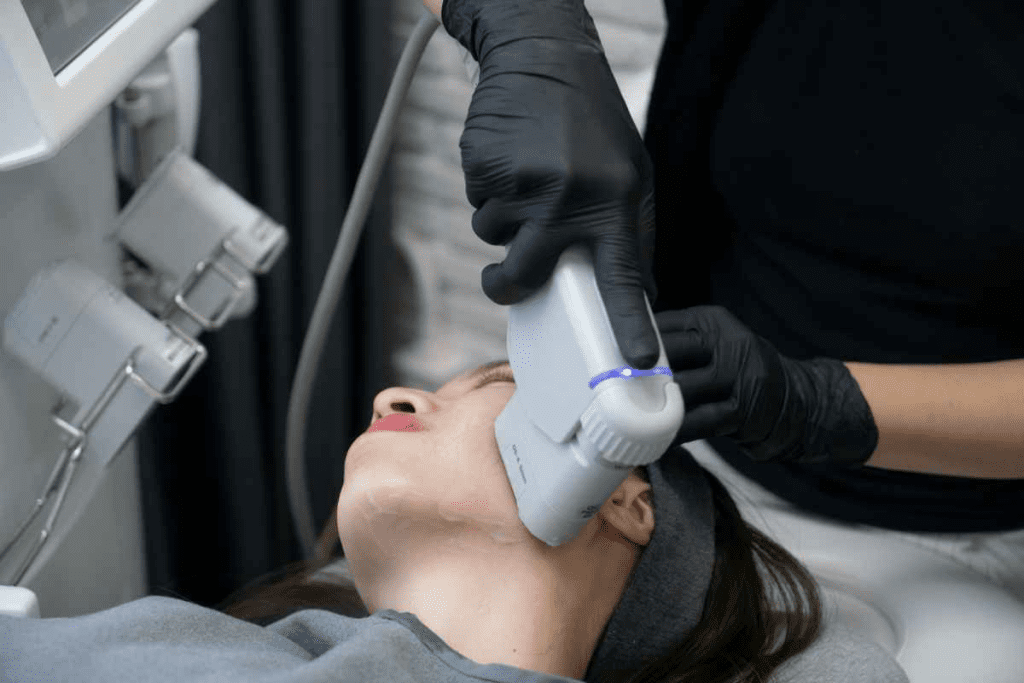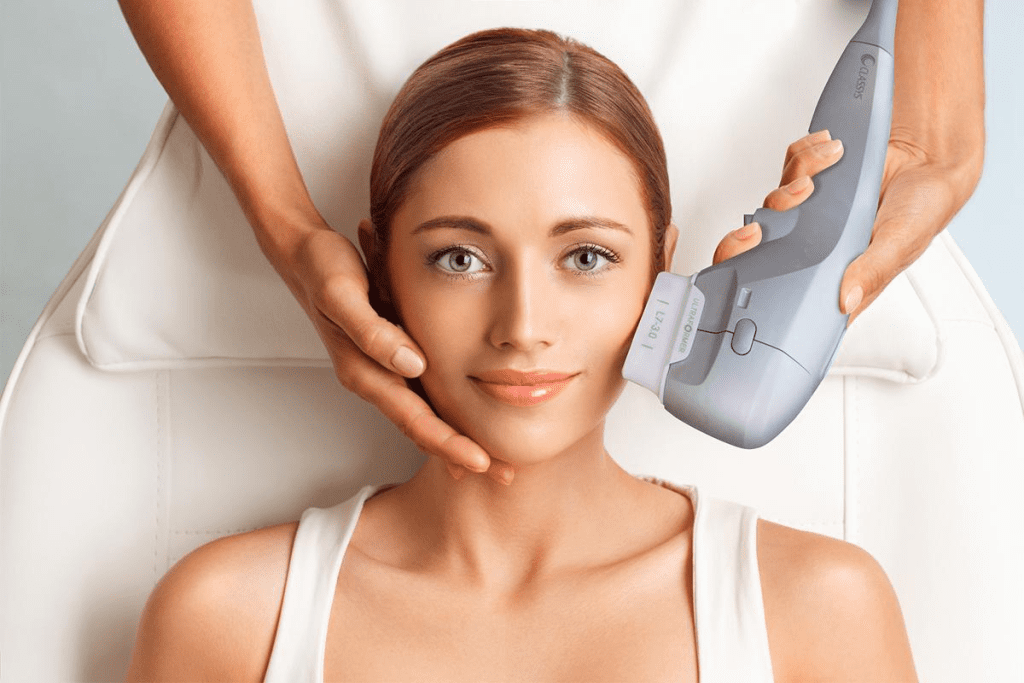Last Updated on November 26, 2025 by Bilal Hasdemir

Did you know over 70% of people aged 35-55 worry about aging signs like sagging skin and wrinkles? High-Intensity Focused Ultrasound (HIFU) is a popular non-invasive treatment for these issues. Learn about the efficacy and applications of HIFU (High-Intensity Focused Ultrasound) treatment in various medical fields.
HIFU is known for its effectiveness in skin tightening, facial rejuvenation, and body contouring. It’s a non-invasive option, making it a great choice instead of surgical facelifts.
Key Takeaways
- HIFU is a non-invasive cosmetic treatment.
- It is effective for skin tightening and facial rejuvenation.
- HIFU offers a promising alternative to surgical facelifts.
- The treatment is gaining popularity among those concerned about aging.
- HIFU is used for body contouring as well.
Understanding HIFU Technology
HIFU technology uses ultrasound to boost collagen and tighten skin. It’s a non-surgical method that’s become popular for its effective results.
What is High-Intensity Focused Ultrasound?
High-Intensity Focused Ultrasound (HIFU) is a modern technology. It uses ultrasound energy to target deep skin layers. This energy boosts collagen production, making skin tighter and younger-looking.
The Science Behind HIFU
HIFU works by sending focused ultrasound energy deep into the skin. This energy heats the area, encouraging collagen production. The result is skin that looks tighter and more youthful.
A device emits ultrasound waves for this treatment. These waves go deep into the skin, stimulating collagen. The treatment can be tailored to fit each patient’s needs.
How HIFU Differs from Other Treatments
HIFU stands out from treatments like laser or radiofrequency. These methods also aim to improve skin, but they use different energies. HIFU’s focused ultrasound energy reaches deeper layers more effectively.
| Treatment | Energy Type | Depth of Penetration |
| HIFU | Focused Ultrasound | Deep tissue layers |
| Laser Therapy | Light Energy | Surface to moderate depth |
| Radiofrequency | Electrical Energy | Moderate depth |
Knowing the differences between treatments is key. HIFU’s unique approach makes it a top choice for those wanting non-surgical skin tightening and body shaping.
The Evolution of HIFU Treatment

HIFU treatment has seen a lot of changes over the years. It started in medicine and now is used for beauty treatments too. These changes have made HIFU better and more popular for different uses.
Historical Development
HIFU has been around for many years, first for medical use. It was first looked into in the 1940s and 1950s. But it took time for it to be studied and used more.
At first, HIFU was used to treat diseases like cancer. It was complex and not easy to get. But as it got better, it started being used for beauty treatments too.
Modern Advancements in HIFU Technology
Today, HIFU is used for beauty, like making faces look younger and bodies look better. New HIFU devices can target specific areas well. This makes the treatment safer and more effective.
HIFU now helps make more collagen, which tightens the skin. This is why it’s a favorite for non-surgical facelifts and body shaping. The technology keeps getting better, with new research and ideas.
Key advancements include better device accuracy, safety features, and special beauty treatments. These changes have made HIFU a popular choice for beauty treatments.
HIFU for Facial Rejuvenation
HIFU facial rejuvenation is a new, non-invasive treatment. It helps people look younger without surgery. It uses high-intensity focused ultrasound to make more collagen, tightening and lifting the skin.
How HIFU Works for Skin Tightening
HIFU sends focused ultrasound energy deep into the skin. This energy makes new collagen. It tightens loose skin, reduces wrinkles, and boosts skin elasticity.
The device used in HIFU sends out ultrasound waves. These waves heat the skin’s deeper layers. This natural response makes more collagen, improving skin texture and firmness over time.
Target Areas for Facial HIFU
Facial HIFU treats many areas of the face and neck. Common spots include:
- The eyebrows, to lift and shape
- Nasolabial folds, to reduce deep lines
- The neck, to tighten loose skin and improve definition
- The face, to enhance overall skin texture and reduce aging signs
HIFU facial treatments rejuvenate the face comprehensively. They address multiple aging signs in one go.
Expected Results from HIFU Facial Treatments
People who get HIFU facial rejuvenation see tighter, smoother skin. Results come gradually, getting better over months as collagen builds up. Most notice:
- Lifting and tightening of the skin
- Less visible fine lines and wrinkles
- Better skin elasticity and firmness
These effects last a long time. Studies show results can last up to a year or more. This depends on the person’s skin and lifestyle.
Effectiveness of HIFU Face Lifting

Clinical studies show HIFU works well for tightening skin and shaping faces. It’s a non-surgical way to lift and tighten without surgery.
Before and After: What to Expect
People who get a HIFU face lift see big changes in their face. Right away, you might not see the full effect. But, as it boosts collagen, the real results show up weeks to months later.
Clinical Studies on HIFU Facelift Results
Many studies have looked into HIFU’s face lifting effects. They all agree: HIFU makes skin tighter and faces look better. These changes last from months to years.
Duration of Results
How long HIFU results last varies. It depends on your skin, age, and lifestyle. Usually, the effects last 12 to 24 months. Some might need more treatments to keep the look.
Factors Affecting HIFU Facelift Outcomes
Several things can change how well HIFU works. This includes how loose your skin is, how many treatments you need, and your health. Getting ready for treatment and taking care after are key for the best results.
HIFU for Body Contouring
HIFU technology now helps with body shaping, not just the face. It’s a non-surgical way to reduce fat. This means you can get the body you want without surgery.
Target Areas Beyond the Face
HIFU works on more than just the face. It targets the abdomen, thighs, and arms. These spots often hold fat that’s hard to lose with diet and exercise.
- Abdomen: HIFU can slim down belly fat and make the stomach look better.
- Thighs: It helps with fat on the inside and outside of the legs, making them look more defined.
- Arms: HIFU can also cut down on arm fat, giving arms a more toned look.
Effectiveness for Fat Reduction
Research shows HIFU is good for losing fat. It uses high-intensity ultrasound to kill fat cells. Then, the body gets rid of them naturally.
| Treatment Area | Average Fat Reduction | Number of Sessions |
| Abdomen | 25% | 2-3 |
| Thighs | 20% | 2-3 |
| Arms | 15% | 2 |
Comparing HIFU with Other Body Contouring Methods
There are many ways to shape your body, both surgical and non-surgical. HIFU is a non-invasive option with little downtime.
It’s safer than surgery, like liposuction, with fewer risks. It’s also better than non-surgical options like CoolSculpting. HIFU can treat more areas of the body.
Medical Applications of HIFU Therapy
HIFU therapy is not just for beauty. It’s also used in medicine to treat different health issues.
Cancer Treatment
HIFU is seen as a new hope for some cancers. It’s non-invasive and can target specific areas, making it appealing to patients.
Key benefits of HIFU in cancer treatment include:
- Minimally invasive with fewer side effects
- Precise targeting of tumor tissue
- Potential for treating tumors in sensitive areas
| Cancer Type | HIFU Application | Status |
| Prostate Cancer | Tumor ablation | Clinical trials |
| Pancreatic Cancer | Palliative care, tumor reduction | Ongoing research |
| Liver Cancer | Tumor ablation | Approved in some countries |
Uterine Fibroids
HIFU is also used for treating uterine fibroids. It’s a non-surgical option compared to traditional methods.
The benefits of HIFU for uterine fibroids include:
- Reduced symptoms without surgery
- Faster recovery compared to traditional surgical methods
- Preservation of uterine function
Other Therapeutic Uses
HIFU is also being explored for other medical uses. This includes neurological disorders and pain management.
Potential future applications may include:
- Neurological conditions such as Parkinson’s disease
- Chronic pain management
- Other diseases where precise tissue ablation is beneficial
The HIFU Treatment Process
Getting the most out of HIFU starts with knowing the treatment steps. This includes getting ready before the treatment, the actual HIFU session, and caring for your skin after. This way, patients know what to expect and can prepare well.
Pre-Treatment Preparation
Before starting HIFU, several steps are taken. Consultation is the first, where a healthcare expert checks if HIFU is right for you. You’ll talk about your health history, skin, and what you hope to achieve. It’s important to remove makeup and clean your skin for the best results.
A professional notes, “Getting ready right is key for a good HIFU treatment. Clean skin without makeup helps the energy work better.”
“The success of HIFU depends a lot on how well you prepare and the skill of the practitioner,” says a well-known dermatologist.
What Happens During a HIFU Session
In a HIFU session, a practitioner uses a special device to send focused ultrasound energy to specific areas. The time needed can range from 30 minutes to several hours, depending on the area and your needs. You might feel a bit of discomfort, but it’s usually not too bad and doesn’t last long.
HIFU technology targets deep tissues well, helping to make collagen and tighten skin. How many sessions you need depends on your goals and the area treated.
Post-Treatment Care
After a HIFU session, you can usually go back to your normal activities right away. But, you might see some mild redness or swelling, which should go away in a few hours. Your practitioner might suggest gentle skin care and sun protection to keep your skin looking good and help it heal.
To get the most from HIFU, you might need to come back for more treatments, as your practitioner advises. Taking care of your skin and living a healthy lifestyle can help keep the results lasting longer.
Benefits of HIFU Treatment
HIFU treatment offers many advantages, including long-lasting results and a safe profile. It’s a non-invasive therapy that has changed the cosmetic treatment field. It’s a great choice compared to surgery.
Non-Invasive Nature
The biggest benefit of HIFU is that it’s non-invasive. Unlike traditional facelifts, HIFU doesn’t need cuts or foreign objects. This lowers the risk of problems and appeals to those scared of surgery.
Minimal Downtime
Non-invasive HIFU also means little downtime. Most people can go back to their daily life right after. This is great for those with no time to spare.
- Quick recovery lets you go back to work or social events fast.
- It has few side effects, so you can get back to normal quickly.
Long-Term Results
HIFU is known for its long-term results. It boosts collagen, making skin tighter and smoother over time. Results can last months to a year or more.
Safety Profile
The HIFU safety profile is a big plus. Being non-invasive, it avoids many surgery risks. Studies show it’s safe and works well for face and body treatments.
| Benefits | Description |
| Non-Invasive | No surgical incisions or insertion of foreign objects. |
| Minimal Downtime | Quick recovery allowing immediate return to daily activities. |
| Long-Term Results | Stimulates collagen production for continued improvement. |
| Favorable Safety Profile | Non-invasive nature reduces risks associated with surgery. |
In summary, HIFU is a good choice for those wanting to look better without surgery. It’s safe, has little downtime, and can last a long time. These reasons make HIFU a top pick in cosmetic treatments.
Potential Side Effects and Risks of HIFU
HIFU is a non-invasive treatment that is generally safe. But, it’s important to know about its side effects and risks. Before you get treated, make sure you understand these.
Common Side Effects
Most people do well with HIFU. But, some might feel a few side effects. These can include:
- Temporary redness and swelling in the treated area
- Slight bruising or numbness
- Mild discomfort during or after the procedure
These effects are usually mild and go away in a few days.
Rare Complications
Though rare, serious complications can happen. These might include:
- Permanent nerve damage
- Severe bruising or hematoma
- Infection, though this is extremely rare with proper post-treatment care
Following the post-treatment instructions carefully can help avoid these risks.
Who Should Avoid HIFU
Some people should not get HIFU. These include:
- Pregnant or breastfeeding women
- Individuals with certain medical implants (e.g., pacemakers, metal implants in the treatment area)
- Those with severe skin conditions or open wounds in the treatment area
Talking to a qualified healthcare provider is key. They can tell you if HIFU is right for you.
HIFU vs. Alternative Treatments
HIFU is a standout in facial rejuvenation, being non-surgical. It offers notable benefits. Knowing the differences between treatments is key for those looking to refresh their look.
Surgical Facelifts vs. HIFU
Surgical facelifts and HIFU aim to rejuvenate the face but in different ways. Surgical facelifts remove excess skin and tighten muscles through surgery. HIFU, on the other hand, is non-invasive. It uses ultrasound to boost collagen and tighten skin.
“HIFU is a less invasive choice with fewer risks than surgical facelifts,” says a top aesthetic expert. This makes HIFU a great option for those who don’t want surgery.
Radiofrequency Treatments vs. HIFU
Radiofrequency (RF) treatments and HIFU both aim to tighten skin and boost collagen. But they use different technologies. RF uses electrical energy, while HIFU uses focused ultrasound.
- HIFU targets deeper layers of tissue.
- RF is better for tightening the skin’s surface.
Choosing between HIFU and RF depends on your skin concerns and goals.
Laser Therapies vs. HIFU
Laser therapies and HIFU are used for skin rejuvenation and tightening. Laser therapies work on the skin’s surface. HIFU, on the other hand, targets deeper layers to stimulate collagen.
Laser therapies are good for surface issues like fine lines and spots. HIFU is preferred for lifting and tightening the skin without surgery.
Thread Lifts vs. HIFU
Thread lifts and HIFU are non-surgical options for facial rejuvenation. Thread lifts use sutures to lift facial tissues. HIFU stimulates collagen to achieve a similar effect.
“HIFU is a more subtle approach, gradually improving skin texture and tightness over time,” says an aesthetic expert.
In conclusion, when comparing HIFU to other treatments, consider your needs and preferences. Each treatment has its own benefits and drawbacks, making some more suitable than others for certain concerns.
Cost Analysis of HIFU Treatment
HIFU treatment costs vary a lot in the United States. Several factors can affect the price. It’s important for those interested to know about these costs.
Average Pricing in the United States
In the U.S., HIFU treatment can cost between $1,500 and $6,000 per session. The price depends on the area treated and how many sessions you need. For example, a facial rejuvenation session might cost $1,500 to $3,000. Body contouring treatments can be $2,000 to $6,000 per session.
| Treatment Area | Average Cost per Session | Number of Sessions |
| Facial Rejuvenation | $1,500 – $3,000 | 1-2 |
| Body Contouring | $2,000 – $6,000 | 1-3 |
Factors Affecting HIFU Treatment Cost
Several things can change the cost of HIFU treatment. These include:
- Location: Prices can differ a lot based on where you are.
- Provider Expertise: More experienced providers might charge more.
- Treatment Area: Bigger areas cost more because they take longer.
- Number of Sessions: More sessions mean a higher total cost.
A study in a Journal shows HIFU is cost-effective. It’s a good option compared to surgery, even though it costs more upfront.
“HIFU offers a non-invasive solution with potentially fewer risks and less downtime compared to traditional surgical facelifts.” – A Dermatologist
Insurance Coverage and Financing Options
HIFU treatments are usually not covered by insurance because they are cosmetic. But, some providers offer financing or package deals. These can help make the treatment more affordable.
It’s key for those thinking about HIFU to talk to a qualified provider. They can help understand the costs based on your needs and budget. This way, you can make a well-informed decision about your care.
Finding Quality HIFU Treatment Near You
Finding the right HIFU provider is key for a safe and successful treatment. With many clinics and practitioners, it’s important to research and choose wisely.
Qualifications to Look For in Providers
When looking for a HIFU provider, there are important qualifications to check. These include:
- Certification: Make sure the practitioner is certified by a well-known organization, like the American Board of Dermatology or the American Board of Plastic Surgery.
- Experience: Look for providers with lots of experience in HIFU treatments. Ask about their success stories and how many treatments they’ve done.
- Training: Check if the practitioner has the right training for the HIFU technology they use.
It’s also smart to read online reviews and ask friends or family who have had HIFU treatment for recommendations.
Questions to Ask Before Treatment
Before getting HIFU treatment, it’s important to ask the right questions. Some key ones include:
- What are the possible risks and side effects of HIFU treatment?
- How many treatments will I need to get the results I want?
- What kind of support and aftercare can I expect?
- Are there other treatments that might be better for me?
Asking these questions helps you understand what to expect and make a better choice.
Red Flags to Watch Out For
When looking for a HIFU provider, watch out for red flags. These can mean a lack of quality or expertise. Some red flags include:
- Unrealistic promises: Be cautious of providers who promise too much or say HIFU is a miracle cure.
- Lack of transparency: If a provider is secretive about their qualifications, experience, or risks of HIFU, it’s a warning sign.
- Poor communication: Notice how well the provider listens and answers your questions. Bad communication can be a big problem.
Knowing these red flags helps you avoid problems and find a qualified provider.
Real Patient Experiences with HIFU
Patient experiences with HIFU are varied. This non-invasive treatment can lead to amazing results or disappointing outcomes. It’s used for facial rejuvenation and body contouring, attracting many patients. Knowing the different results is key for those thinking about trying it.
Success Stories
Many have seen great benefits from HIFU. For example, a 45-year-old woman got her skin tightened after treatment. Her results lasted over a year. Such success stories are common, with many praising the treatment’s effectiveness and quick recovery time.
A study in a Journal found most patients were happy with HIFU. They noticed better skin and looked younger. These positive experiences show HIFU can make a big difference.
Disappointing Results
Not everyone has a positive experience with HIFU. Some see little to no change or need more treatments. The severity of the condition, the practitioner’s skill, and individual responses can affect results.
Online forums show a mix of opinions. Some are unhappy due to unmet expectations or poor results. It’s important to have realistic hopes and talk to a qualified practitioner before starting.
What the Research Says About Patient Satisfaction
Research on HIFU satisfaction is mixed but mostly positive. A review of studies found most patients were happy with their results. But, results varied depending on how HIFU was used (for the face or body).
| Study | Sample Size | Satisfaction Rate |
| Journal of Clinical and Aesthetic Dermatology | 100 | 85% |
| Dermatologic Surgery Journal | 50 | 90% |
| Aesthetic Plastic Surgery Journal | 200 | 78% |
The table shows the satisfaction rates from several studies. It highlights the range of opinions on HIFU treatments.
Conclusion: Is HIFU Treatment Right for You?
Choosing HIFU treatment depends on many things. These include your beauty goals, health history, and what you prefer. HIFU is a non-invasive way to improve your face and body, and it can help with some health issues too.
Before deciding on HIFU treatment, think about your skin, how serious your concerns are, and what you hope to achieve. It’s key to talk to a skilled provider. They can help figure out if HIFU fits your needs.
Knowing the good and bad of HIFU, and its cost, helps you decide. Whether HIFU is for you depends on your specific situation and what you want. Do your homework and talk to experts to choose wisely for your beauty or health needs.
Is HIFU right for you? The answer comes from looking at your own needs and talking to a healthcare expert.
FAQ
What is HIFU treatment?
HIFU stands for High-Intensity Focused Ultrasound. It’s a non-invasive way to improve your skin. It uses sound waves to make your skin tighter and reduce fat.
How does HIFU work?
HIFU sends focused sound waves into your skin. These waves help make collagen and tighten your skin.
What areas can HIFU treat?
You can use HIFU on many parts of your body. This includes your face, neck, belly, arms, and thighs. It helps tighten your skin and reduce fat.
Is HIFU painful?
Some people might feel a bit uncomfortable during HIFU. But most find it okay. Your provider might offer ways to make it less painful.
How long do HIFU results last?
The effects of HIFU can last from months to years. This depends on your skin, how you live, and if you get more treatments.
What is the cost of HIFU treatment?
HIFU prices vary. They depend on where you are, who does it, and where you get treated. On average, it costs between $1,500 and $3,500 per session.
Are there any side effects of HIFU?
Yes, some side effects are common. These include redness, swelling, and bruising. But very rarely, it can cause nerve damage or burns.
Who is a good candidate for HIFU?
If you have mild to moderate loose skin, HIFU might be for you. It’s also good for those who want a non-surgical way to tighten their skin and reduce fat.
Can HIFU be used for body contouring?
Yes, HIFU can help shape your body. It targets areas like your belly, arms, and thighs to slim them down and improve your skin’s look.
How many HIFU sessions are needed?
The number of sessions needed varies. It depends on what you want to achieve and where you want to treat. Usually, one to three sessions are enough.
Is HIFU FDA-approved?
Yes, the FDA has cleared HIFU for tightening skin and reducing fat. It’s safe and effective.
Can HIFU be combined with other treatments?
Yes, you can use HIFU with other treatments. This includes injectables or chemical peels. It helps get even better results and a more complete rejuvenation.
References
- European Society for Medical Oncology. (2025). ESMO Clinical Practice Guidelines: Gynaecological Cancers. https://www.esmo.org/guidelines/esmo-clinical-practice-guidelines-gynaecological-cancers
- National Institute for Health and Care Excellence. (2023). Ovarian cancer: recognition and initial management (NG122). https://www.nice.org.uk/guidance/cg122
- Society of Gynecologic Oncology. (2023). Ovarian Cancer Screening and Symptom Awareness Consensus Statement. https://www.sgo.org/news/ovarian-cancer-screening-and-symptom-awareness-consensus-statement/






